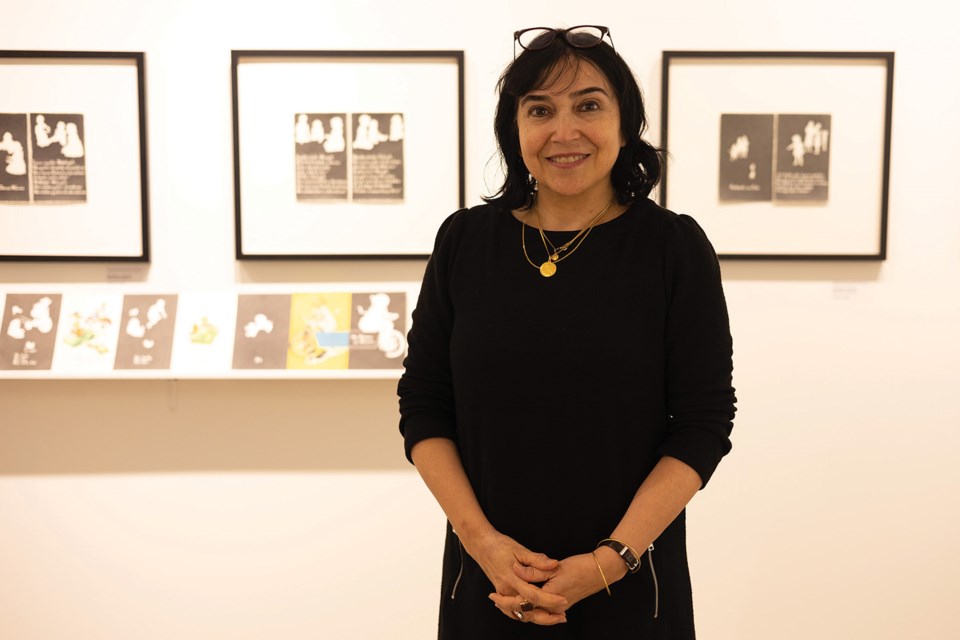When Iranian-born artist Mehran Modarres-Sadeghi first encountered the Dick and Jane books once commonplace as English primers for North American schoolchildren, the stories and their settings seemed completely alien.
She was a Farsi-speaking girl growing up in Isfahan, a city built around the minarets of the 17th-century Shah Mosque. Images of dungaree-wearing toddlers living in an idealized version of American suburbia were like glimpses of a different species.
“The architecture was so beautiful; the grass was so green,” she recalled. “We didn’t have these sorts of things there [in Iran]. The images were so strange and nothing like our culture. But we loved it because it was colourful and we loved to look at it.”
The illustrated tales gave Modarres-Sadeghi a foundation in the English language. When she moved to Canada in the 1990s after obtaining an undergraduate degree in physics, she packed her copy of Dick and Jane for sentimental reasons.
During a public reception at the Gibsons Public Art Gallery on Nov. 2 (and at a lecture last weekend), the now Vancouver-based Modarres-Sadeghi revealed that she felt driven to translate the Dick and Jane stories — both text and images. The result is a series of graphite silhouettes accompanied by hand-lettered Farsi transliterations using the Roman alphabet. In the panoramic Ma Miaeem va Miravim (We Come and Go) 15, original illustrations from the book appear alongside their black-and-white reflections. Cherubic figures at play are separated from their toys and backgrounds, reduced to crisp-lined essences.
Modarres-Sadeghi’s three-dimensional art also incorporates her distinctive approach of wrapping essential shapes in black. Around iconic Iranian artifacts like hand-crafted samovars (metal containers traditionally used to boil water) and a parch (pitcher), she weaves black string into intricate webs. The same treatment is applied to North American relics like a skateboard (once owned by her son), headphones and roller skates. The process embodies the personal linking of diverse traditions and lived memories.
“It’s just scissors and string — nothing else —, just wrapping and knotting to make this unified shape in three dimensions,” she explained. “It’s also drawing, because thread is like a tracing with pen or pencil. The thread goes back to the stories and connections from one culture to another culture.”
The webbing over three sini trays (fashioned in traditional copper) is strung above each item’s surface; the intersections of dark thread cast shifting shadows as viewers circle the works.
Modarres-Sadeghi’s Safar (A Journey), Thread, and Lost Gardens series represent her long-awaited return to the Sunshine Coast. Her first exhibition on the Coast, in March 2020 at the Sunshine Coast Arts Centre, was cut short due to COVID-19 restrictions.
Her Lost Gardens drawings depict preserved plants from the herbarium collection at the Beaty Biodiversity Museum at UBC. Their meticulous contours reflect a veneration of species at risk, and occasionally blossom into abstraction — an impulse fully realized in two densely-inked drawings (Modarres-Sadeghi’s twin Lost works), whose serpentine whorls are inspired by Persian calligraphy.
Creating repetitive patterns is a kind of physical meditation, she explained: a way of preserving and celebrating memory. “Even when I go back to Iran,” she said, “I find that stories are getting lost. People are very modern and we are all getting to be the same.”
Safar (A Journey) by Mehran Modarres-Sadeghi remains on display at the Gibsons Public Art Gallery until Nov. 24.



